Russian War Report: Tensions escalate in the Black Sea as the Russian navy forcefully inspects a civilian cargo ship
Russia escalated tensions beyond Ukraine again this week when its navy forcibly inspected and fired warning shots at a civilian cargo ship.
Russian War Report: Tensions escalate in the Black Sea as the Russian navy forcefully inspects a civilian cargo ship
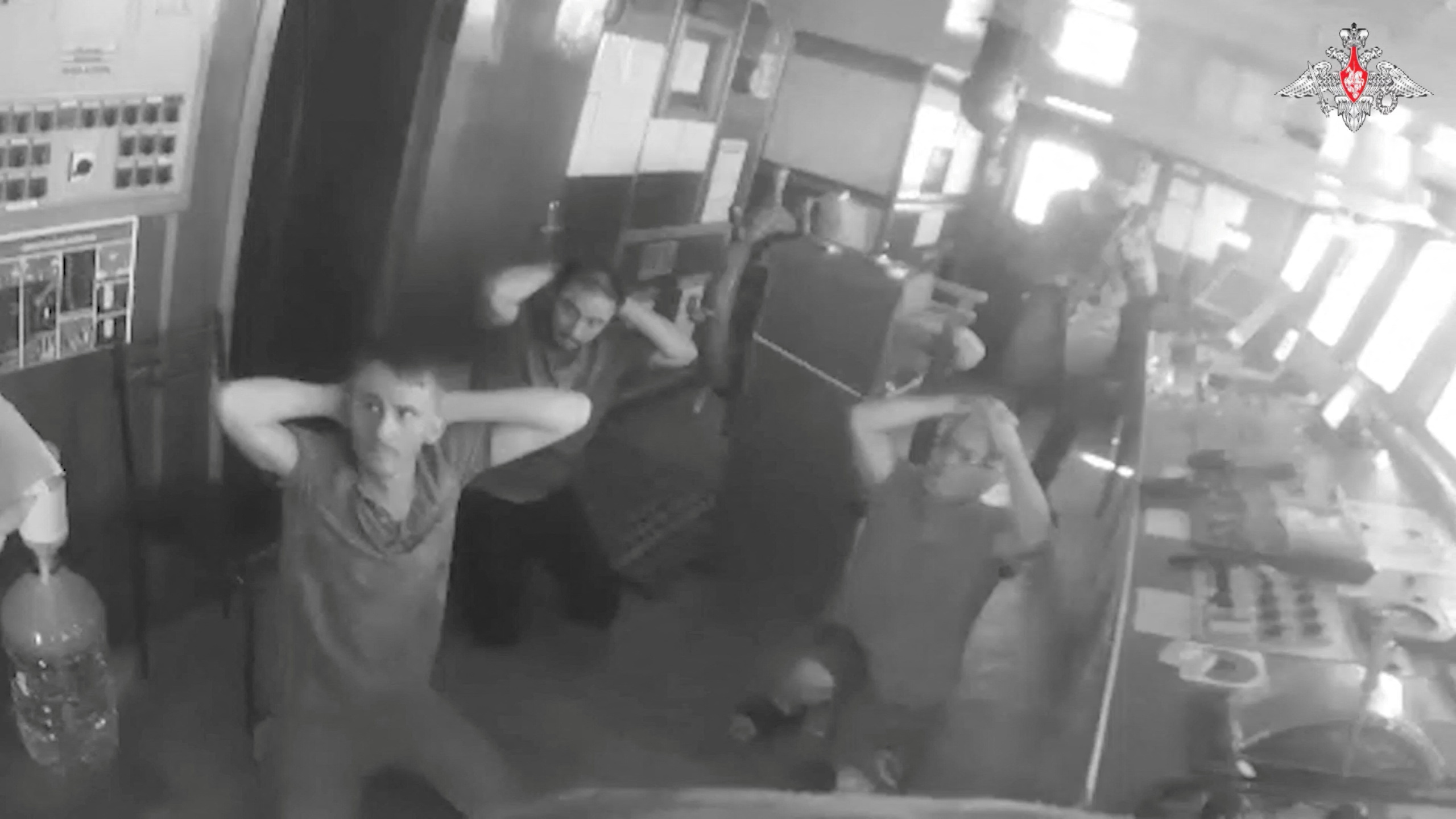
As Russia continues its assault on Ukraine, the Atlantic Council’s Digital Forensic Research Lab (DFRLab) is keeping a close eye on Russia’s movements across the military, cyber, and information domains. With more than seven years of experience monitoring the situation in Ukraine—as well as Russia’s use of propaganda and disinformation to undermine the United States, NATO, and the European Union—the DFRLab’s global team presents the latest installment of the Russian War Report.
Security
Tracking narratives
International response
Russia targets civilian infrastructure as Ukraine continues counteroffensive operations
In the early hours of August 15, Russia carried out missile strikes against Ukraine, killing at least three people and injuring nine. The attacks targeted civilian facilities in eight Ukrainian regions, including residential buildings, educational institutions, and a hospital, according to Ukrainian Prime Minister Denys Shmyhal. Cruise missiles also struck an industrial facility in the western Ukrainian city of Lutsk, near the border with Poland, according to Volyn Governor Yuriy Pohulyaiko. The Ukrainian air force reported on August 15 that Russian forces launched twenty-eight air- and sea-launched cruise missiles, including twenty Kh-101/Kh-555 missiles, four Kh-22 missiles, and four Kalibr missiles.
According to an August 15 report from the General Staff of the Ukrainian Armed Forces, counteroffensive operations are ongoing in Bakhmut, Melitopol, and Berdyansk. However, the Zaporizhzhia region remains the primary battleground and focal point for fighting. Russian military blogger Telegram channel Rybar claimed that Ukrainian forces had advanced south of Dibrova, near the city of Kreminna in western Luhansk Oblast. Footage posted online on August 14 by another Russian Telegram channel indicated that Ukrainian troops had entered the village of Robotyne in Zaporizhzhia. Further, reports from Russian and Ukrainian channels on August 15 suggested that Ukrainian forces had deployed additional brigades to west Zaporizhzhia. The DFRLab has not independently confirmed the veracity of these claims.
Ukrainian military officer Petro Chernyk told Ukrainian outlet ArmyInform that the Ukrainian counteroffensive is advancing slowly in the south due to Russia’s successful defensive lines. Chernyk said the Russian defensive lines included minefields stretching several kilometers, artillery, equipment, personnel concentrations, and rear positions intended to preserve resources.
—Ruslan Trad, resident fellow for security research, Sofia, Bulgaria
Tensions escalate in the Black Sea as the Russian navy forcefully inspects a civilian cargo ship
The Russian navy fired warning shots at and forcibly inspected a civilian dry cargo ship on August 13 as it neared Ukrainian maritime territory.
On August 13, the Russian Ministry of Defense (MoD) posted a message on Telegram indicating it had fired “warning shots” at the grain cargo ship Sukru Okan—which is operated by a Turkish company but sails under a Palau flag—in the Black Sea. The vessel was reportedly heading to the Izmail port in Ukraine. The MoD alleged that, even after firing the warning shots, “the captain of the dry cargo did not respond to the requirement of stopping for the inspection for the transportation of prohibited goods.” According to Russian state media outlet TASS, the Russian navy forcibly stopped the cargo ship to conduct an inspection.
Footage shared online on August 14 showed what appeared to be a Russian Ka-29 helicopter hovering over the deck of the ship. Additional footage released by the Russian MoD revealed how Russian soldiers equipped with automatic weapons interrogated the captain and crew of the ship, forcing them to kneel. The Ukrainian Ministry of Foreign Affairs called the incident a “provocation” that “violated the UN [United Nations] Statute, the UN Convention on the Sea, and other rules of international law.”
After Russia pulled out of the Black Sea Grain Initiative on July 17—following the second successful Ukrainian attack on the Kerch bridge—Russian forces have set out to cut access to Ukraine’s Black Sea ports, resulting in difficulties exporting Ukrainian grain. Although the Russian MoD issued a warning on July 19 indicating that it would consider vessels operating in Ukraine’s maritime space as potential military targets, this is the first incident involving the Russian navy and a civilian cargo ship.
Further, the port of Izmail is located on the Danube River, at the border between Romanian and Ukrainian maritime territories. As such, Russian efforts to inspect civilian cargo ships also affect marine traffic to other southern European harbors.
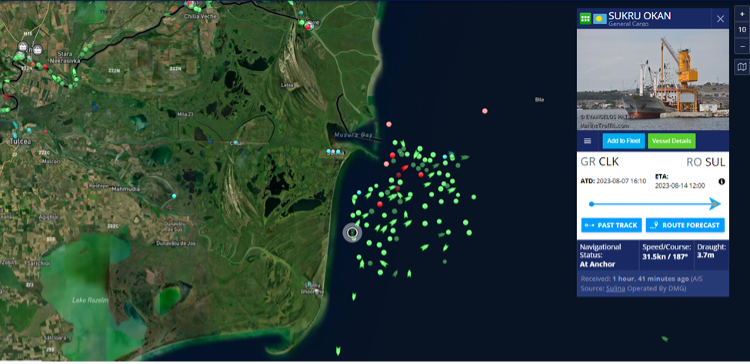
In a CNN interview, an official of the Turkish company operating the Sukru Okan refuted Russia’s allegations. He said the ship reportedly tried to return to Turkish waters as soon as the Russian warship radioed it. He alleged that the inspection occurred in international waters. According to Russian state media, the ship was allowed to follow its path to Izmail, however, the Sukru Okan official stated that the ship decided to remain in Romanian waters near the Sulina Canal. The official’s claim appeared consistent with the GPS position of the ship available on MarineTraffic.com.
—Valentin Châtelet, research associate, Brussels, Belgium
Poland arrests two Russian citizens for trying to recruit Poles to join Wagner
On August 10, Krakow City Council member Lukasz Wantuch posted on Facebook about Wagner recruitment posters appearing in public areas. The posters featured Wagner’s name and logo alongside the English text, “We are here” and “Join us.” The posters contained a QR code that led to Russian-language Wagner recruitment website “группа-вагнера.online” (“Wagner-Group.Online”). A WHOIS query revealed that the website was created on June 25, 2023, and is hosted on an NS.HOSTLAND server, located in Saint Petersburg. The website landing page shares a list of documents required to join Wagner and a phone number to a Wagner call center.
On August 11, the Ukrainian news portal Noviny.LIVE published a video on Telegram allegedly depicting a person putting up a Wagner poster near the Vistula River in Warsaw. On August 14, the Polish Internal Security Agency (ABW) announced the detention of two Russian citizens, Aleksei T. and Andrei G. (ABW did not release their full names), who had allegedly conducted clandestine activities on behalf of Russian special services. The ABW press release stated that the suspects placed about three hundred Wagner recruitment posters in Krakow and Warsaw between August 10 and 11. ABW added that the Russian citizens had more than three thousand “propaganda materials promoting the Wagner Group” on them, which they reportedly received in Moscow. ABW said the Russian pair, arrested on August 11, planned to leave Poland on August 12.
Rumors about Wagner’s interest in Poland began to actively circulate in the information space in July 2023. During a July 22 meeting with Russian President Vladimir Putin, Belarusian President Alyaksandr Lukashenka claimed that Wagner members in Belarus are pushing him to allow them to “go on an excursion to Warsaw and Rzeszow.” He added that he knew Wagner fighters had bad intentions toward Poland. After Lukashenka’s statement, pro-Kremlin sources began to disseminate forged and digitally altered photos claiming to show Wagner fighters on the Polish border.
—Givi Gigitashvili, research associate, Warsaw, Poland
New narrative uses footage of parties to question financial aid to Ukraine
Videos originally posted to TikTok by a user seemingly based in Kyiv showing people partying around the city as a means of emphasizing the resilience of Ukrainians have recently been reappropriated on Twitter. There they took on new life promoting the idea that Ukrainians are supposedly misusing foreign aid to party. The original TikTok user subsequently updated his posts to emphasize the original intent around Ukrainian resilience.
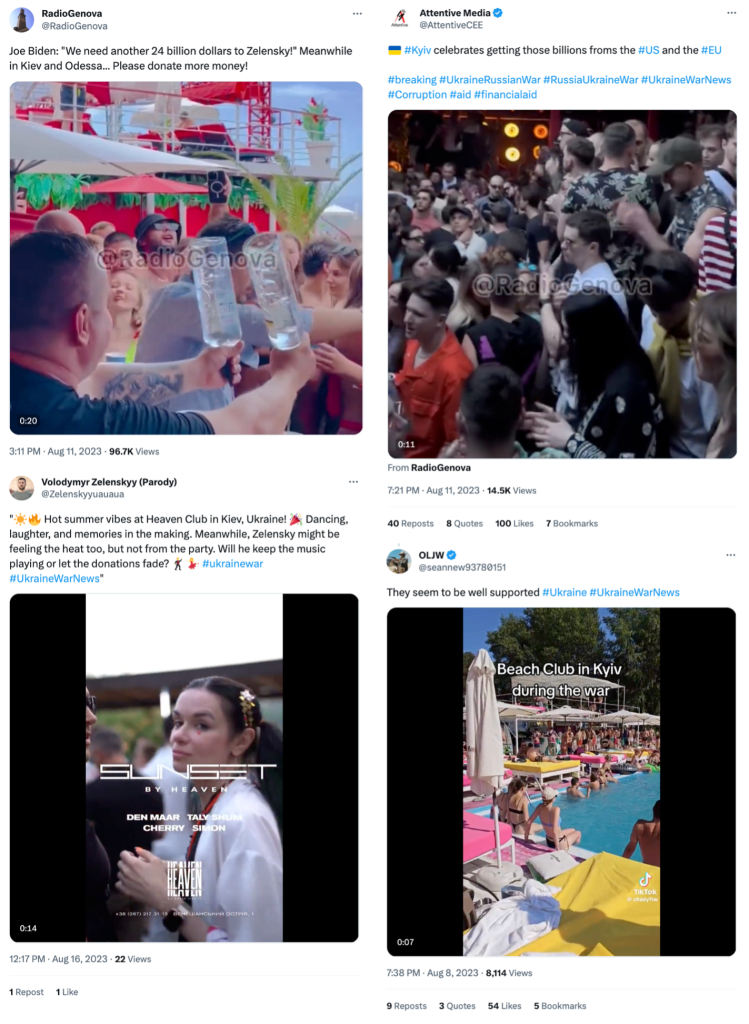
Several videos came from the TikTok account @zhadyftw. The description of the account reads, “Foreigner living in Kyiv 🇺🇦.” Its videos were also amplified after Twitter accounts, such as anonymous account @seannew93780151, reposted them.
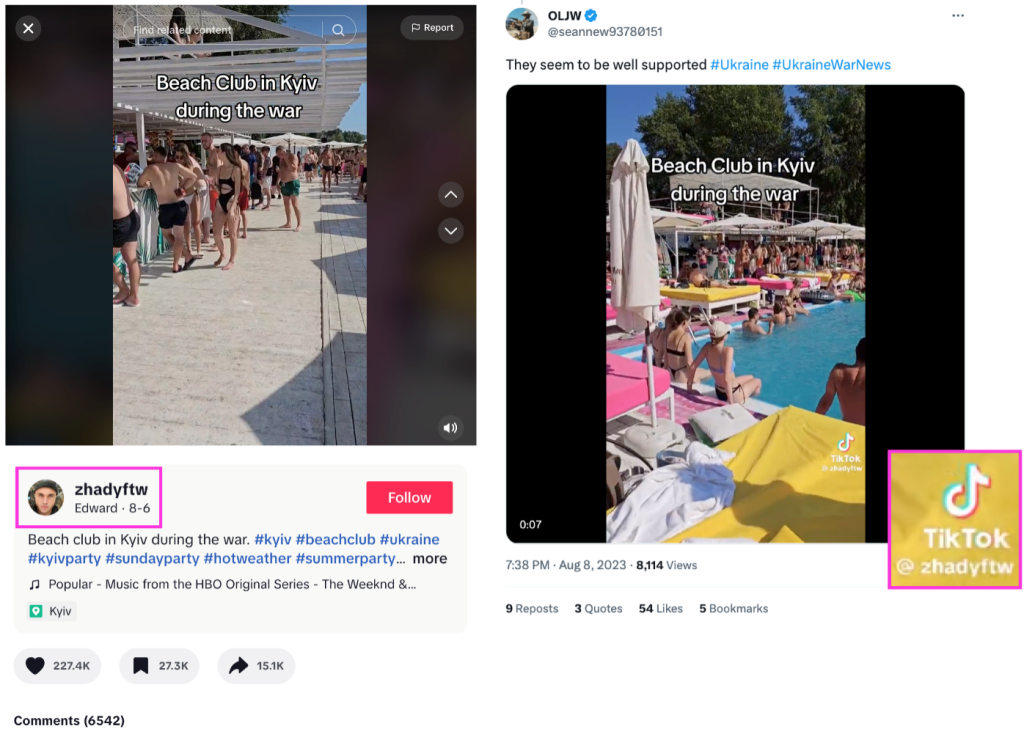
The Twitter account @dom_lucre also reposted some of @zhadyftw’s videos, adding his own watermark and obscuring the original source of the footage. Like the TikTok videos, the Twitter posts garnered significant engagement.
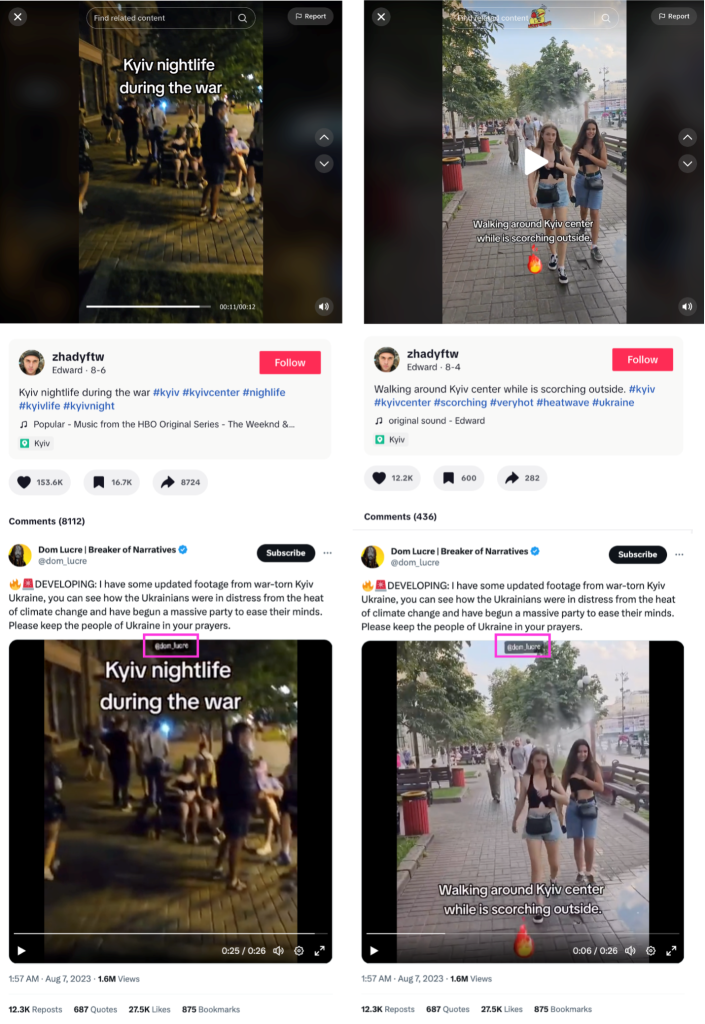
The DFRLab geolocated @zhadyftw’s videos and confirmed they were filmed in Kyiv, as indicated in the description. One video, captioned “Beach Club in Kyiv during the war,” was most likely filmed at the Fifty Beach Club in Kyiv, judging by the pool’s design, the tiles, and the sun beds.
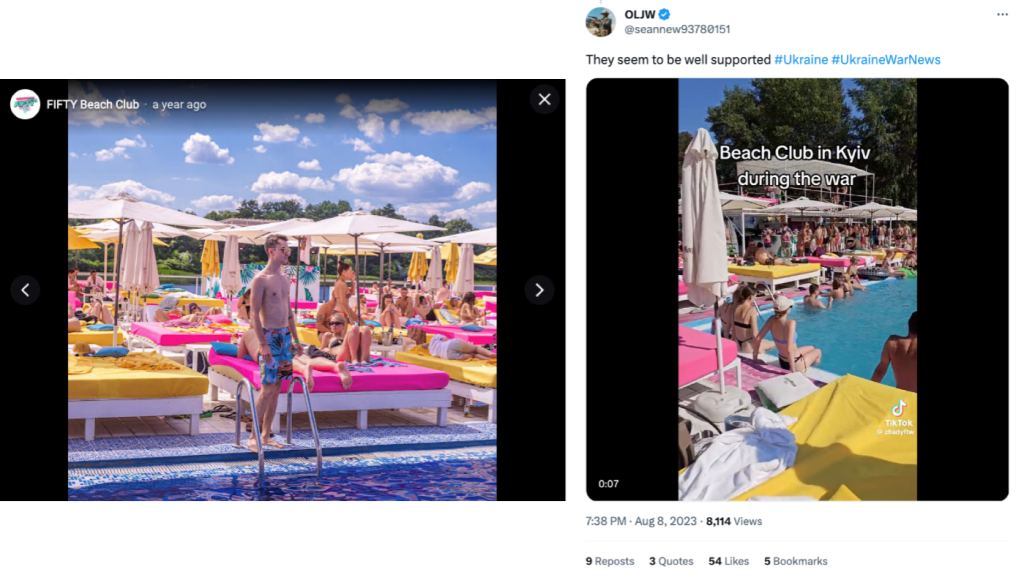
Another video, captioned “Kyiv nightlife during the war,” was partly filmed on Khreschatyk Street in Kyiv.
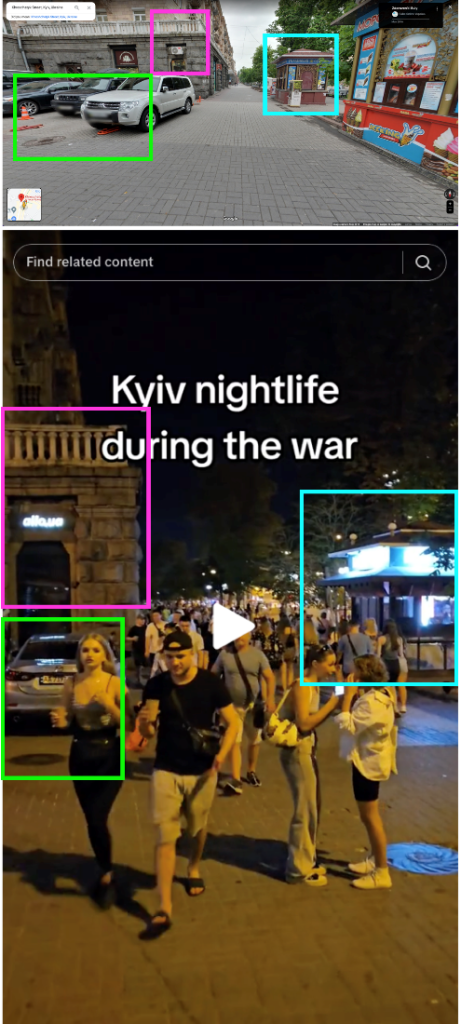
Later, TikTok user @zhadyftw recorded a video explaining that he supports Ukraine and wanted to boost Ukrainian morale because “during moments of war, it is crucial for citizens to find moments of joy, of leisure, which is crucial for maintaining high morale.” He also began to add a disclaimer to his videos, stating, “This doesn’t accurately reflect the situation in Ukraine. Ukrainian civilians are losing their lives daily due to the ongoing Russian aggression.” However, the reposted and watermarked Twitter videos did not contain this disclaimer, thereby obscuring @zhadyftw as the original source and, along with that, any attempt to provide the context that the videos were intended to show the Ukrainian people’s resilience and not their supposed misuse of foreign aid.
—Nika Aleksejeva, resident fellow, Riga, Latvia
Ukraine and its allies seek to expand alternative export routes
Ukraine and its allies are exploring the possibility of increasing grain exports via alternative regional routes. On August 11, officials from Ukraine, Romania, Moldova, the European Union (EU), and the United States held a high-level meeting in the port city of Galati, Romania, to find solutions to the grain crisis in Ukraine.
In the meeting, participants discussed ways to improve rail, road, and maritime grain export options within the EU-Ukraine solidarity lanes, underscoring the critical importance of Romania and Moldova maintaining a steady flow of exports and imports from Ukraine. According to Romanian Transport Minister Sorin Grindeanu, the country’s capacity to transport grain from Ukraine will increase from two million tons per month to four million tons per month “in the next period.” Grindeanu promised to “optimize” the use of the Sulina Canal, one of the Danube River’s three channels to the Black Sea, as part of an EU-funded project.
Moldova has committed to strengthening regional cohesion in support of Ukraine, but to do so, it needs investments in its infrastructure. On August 5, six grain-laden carriages derailed in southern Moldova. The train with sixty-one freight carriages was traveling from Basarabeasca station to the Ukrainian port of Reni. According to Moldovan Railways, the initial cause of the accident was “the extremely high temperature that caused the welded rails to lose strength.” Addressing the issue, Moldovan Minister of Agriculture Vladimir Bolea said, “We are talking about the need to rebuild or invest in the railway and naval infrastructure of the Republic of Moldova, which would make an extraordinary contribution and could even double the amount of goods exported and transited on the territory of the Republic of Moldova in a very short time.”
The United States pledged to work with the Ukrainian government to provide financial assistance, develop export routes, and modernize border crossings. The United States said it would also help improve critical infrastructure, enhance export capacity for the private sector along the Danube River, and provide Romania and Moldova with financial assistance to purchase vessels and facilitate cross-border shipments.
In recent weeks, Ukrainian ports on the Danube River near Moldova and Romania have been subject to Russian bombardment and drone attacks. Among these is the port of Izmail, located about 15 kilometers north of the Romanian Danube port of Tulcea, and Reni, which is only 200 meters across the Danube River from Romania and 7 kilometers from the border of Moldova.
—Victoria Olari, research assistant, Moldova

